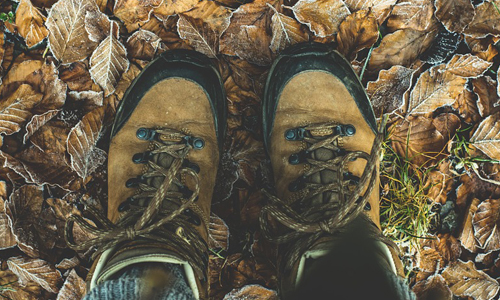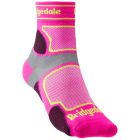Trail Running vs. Hiking Shoes: Making the Right Choice
Author

Javier Olivo is a blogger and a writer by heart. In the past, Javier worked as a woodcarver in a furniture store in his hometown. Being exposed to the outdoors, he often likes to give advice to people who prefer trekking in the woods. During his free time, Javier loves going to the gym and playing football.
In the world of outdoor footwear, the quest for multi-functional shoes is on the rise. With the increasing popularity of outdoor activities, many people wonder if their hiking shoes can be used for running and vice versa. To make an informed decision, it's essential to understand the differences between these two types of shoes and their suitability for various activities. So, let's delve into the details and find out when to lace up your hiking shoes, when to opt for trail running shoes, and how to choose the right pair for your adventures.
Can You Run in Hiking Shoes?
The short answer is yes, you can run in hiking shoes. Both hiking shoes and trail running shoes share some common features, such as lugged treads for traction and low-top designs. However, hiking shoes tend to be stiffer to provide better support and protection on rough terrain. On the other hand, trail running shoes are lighter and offer more flexibility, making them ideal for faster and longer runs.
It's important to consider the duration and terrain of your run. For shorter runs on easy trails, hiking shoes may suffice. However, if you plan to run longer distances or encounter more challenging terrains, trail running shoes will provide better performance and comfort.

When to Wear Hiking Shoes:
Hiking: Hiking shoes are designed for trekking over varied terrain, offering excellent support and durability. They are perfect for longer hikes and backpacking trips, providing protection and stability.
Support and Durability: If you have ankle or knee issues or need a shoe that can withstand tough conditions, hiking shoes are the way to go.
Wet Conditions: Hiking shoes often feature water-resistant materials or even waterproof membranes like Gore-Tex, making them ideal for wet environments.
When to Wear Trail Running Shoes:
Maximise Speed: If your primary goal is speed and agility on the trails, trail running shoes are your best bet. Their lightweight design and cushioning provide comfort and energy efficiency during your runs.
Off-Road Races or Events: For races or events on trails, trail running shoes offer the necessary grip and performance for a competitive edge.
Strong Feet and Ankles: If your feet, ankles, and knees are strong, trail running shoes will provide the support and protection you need for shorter runs.

Choosing Trail Running Shoes for Hiking:
If you decide to opt for trail running shoes for hiking, there are some important factors to consider:
Traction: Look for trail running shoes with deep lugs made of sticky rubber to ensure good traction on varied terrains.
Fit: Choose a shoe with a firm fit in the heel and a roomy toe box to accommodate foot swelling during longer hikes.
Cushioning: Adequate cushioning (around 10mm or more) is crucial to reduce impacts and protect your feet from bruising.
Support: Focus on shoes with a moulded midsole for torsional control and underfoot support.
While both hiking shoes and trail running shoes have their strengths, the key to a successful outdoor adventure lies in choosing the right shoe for the right activity.
-
 Bridgedale Womens Trail Run Ultralight T2 Sport 3/4 Socks£14.23 to £14.46RRP £18.50 Save Up To £4.27
Bridgedale Womens Trail Run Ultralight T2 Sport 3/4 Socks£14.23 to £14.46RRP £18.50 Save Up To £4.27
Author

Javier Olivo is a blogger and a writer by heart. In the past, Javier worked as a woodcarver in a furniture store in his hometown. Being exposed to the outdoors, he often likes to give advice to people who prefer trekking in the woods. During his free time, Javier loves going to the gym and playing football.
Categories
- Sport (28)
- Product Reviews (3)
- Team Outdoor Look (7)
- Mike Wild (2)
- Mike Payton (2)
- Suse Hammond-Pears (3)
- Snowboarding (12)
- Latest Offers (105)
- Shop Talk (1)
- Competitions (7)
- Walking (413)
- Lifestyle Fashion (8)
- Travel (86)
- Kit Guides (176)
- Workwear Clothing (6)
- Safety Workwear (4)
- Health/Fitness (289)
- Skiing (91)
- Great Outdoors (1316)
- Cycling (92)
- January 2025
- December 2024
- November 2024
- October 2024
- September 2024
- August 2024
- July 2024
- June 2024
- May 2024
- April 2024
- March 2024
- February 2024
- January 2024
- December 2023
- November 2023
- October 2023
- September 2023
- August 2023
- July 2023
- June 2023
- May 2023
- April 2023
- March 2023
- February 2023
- January 2023
- December 2022
- November 2022
- October 2022
- September 2022
- August 2022
- July 2022
- June 2022
- May 2022
- April 2022
- March 2022
- February 2022
- January 2022
- December 2021
- November 2021
- October 2021
- September 2021
- August 2021
- July 2021
- June 2021
- May 2021
- April 2021
- March 2021
- February 2021
- January 2021
- December 2020
- November 2020
- October 2020
- September 2020
- August 2020
- July 2020
- June 2020
- May 2020
- April 2020
- March 2020
- February 2020
- January 2020
- December 2019
- November 2019
- October 2019
- September 2019
- August 2019
- July 2019
- June 2019
- May 2019
- April 2019
- March 2019
- February 2019
- January 2019
- December 2018
- November 2018
- October 2018
- September 2018
- August 2018
- July 2018
- June 2018
- May 2018
- April 2018
- March 2018
- February 2018
- January 2018
- December 2017
- November 2017
- October 2017
- September 2017
- August 2017
- July 2017
- June 2017
- May 2017
- April 2017
- March 2017
- February 2017
- January 2017
- December 2016
- November 2016
- October 2016
- September 2016
- August 2016
- July 2016
- June 2016
- May 2016
- April 2016
- March 2016
- February 2016
- January 2016
- December 2015
- November 2015
- October 2015
- September 2015
- August 2015
- July 2015
- June 2015
- May 2015
- April 2015
- March 2015
- February 2015
- January 2015
- December 2014
- November 2014
- October 2014
- September 2014
- August 2014
- July 2014
- June 2014
- May 2014
- April 2014
- March 2014
- February 2014
- January 2014
- December 2013
- November 2013
- October 2013
- September 2013
- August 2013
- July 2013
- June 2013
- May 2013
- April 2013
- March 2013
- February 2013
- January 2013
- December 2012
- November 2012
- October 2012
- September 2012
- August 2012
- July 2012
- June 2012
- May 2012
- April 2012
- March 2012
- February 2012
- January 2012
- December 2011
- November 2011
- October 2011
- September 2011
- August 2011
- May 2010
- April 2010
- March 2010
- February 2010
- January 2010
- November 2009
- October 2009
- September 2009


Submit a Comment